| 22.09.2017/ EN FCI-Standard N° 217 BAYERISCHER GEBIRGSSCHWEISSHUND (Bavarian Mountain Scent Hound) 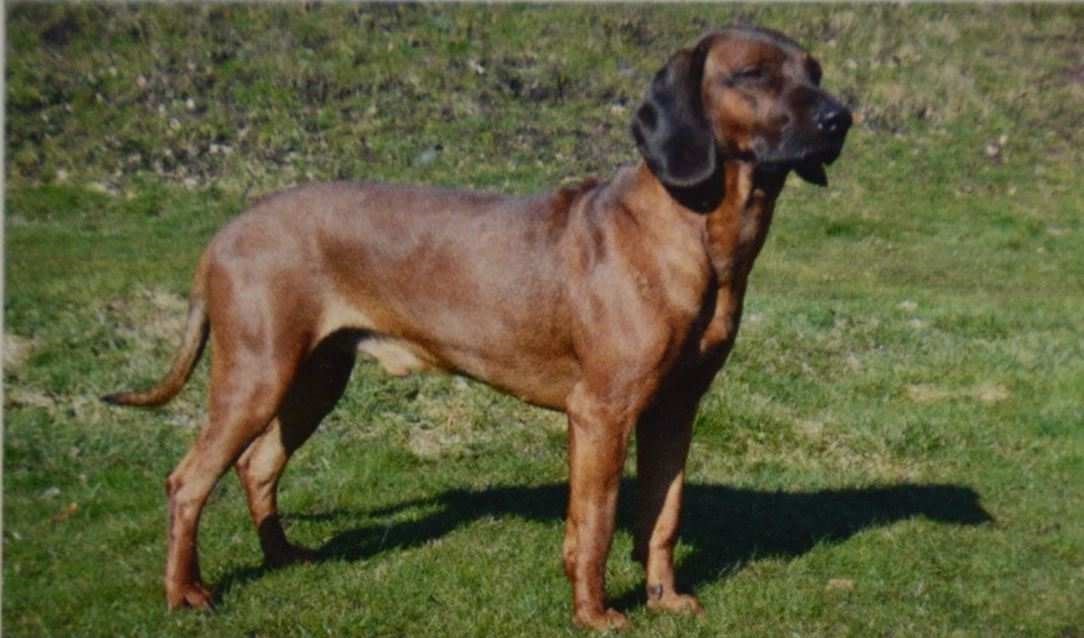
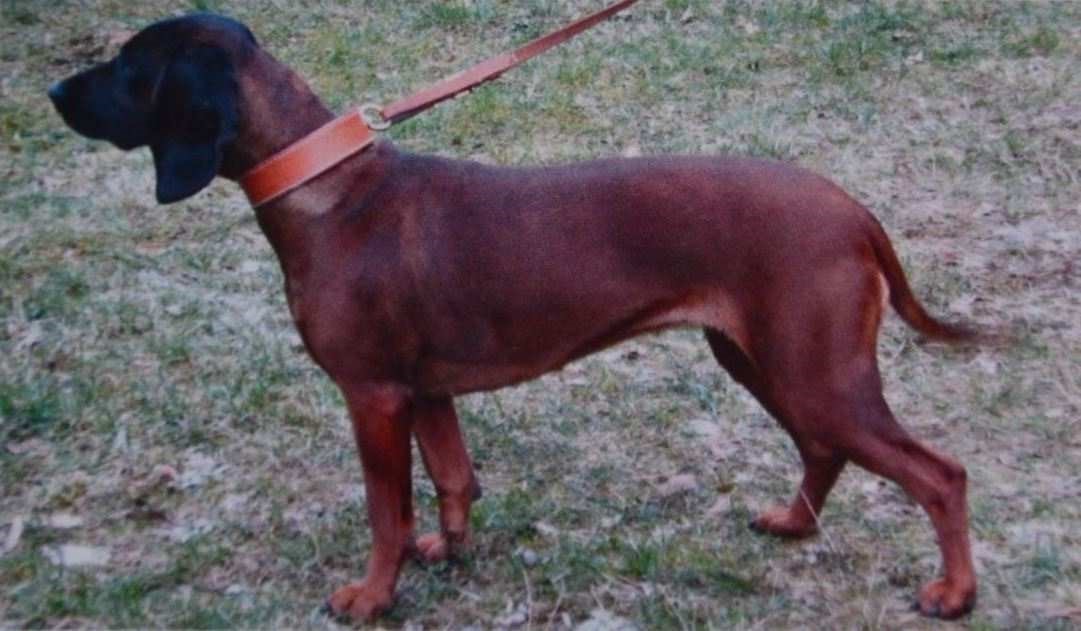
TRANSLATION: C. Seidler, amendments Christina Bailey / Official language (DE). ORIGIN: Germany. DATE OF PUBLICATION OF THE OFFICIAL VALID STANDARD: 22.08.2017. UTILIZATION: In accordance with the hunting requirements as a specialist for the search of hoofed game, the Bavarian Mountain Scent Hound has to show all the of him required abilities to be useful for the more difficult search. This usefulness must be confirmed by the relevant working trials. FCI-CLASSIFICATION: Group 6 Scenthounds and related. Section 2 Leash (Scent) hounds. With working trial, which take note of the relevant hunting requirements. BRIEF HISTORICAL SUMMARY: All Liam Hounds (Leithunde) and Leashhounds (Schweisshunde) are descended from the original hunting dogs, the "Bracken". All pure "Bracken" have the finest nose for following ground scent and trail; they are firm on scent, have a strongly developed will to follow a trail and are readily giving tongue on scent.
Only the most reliable and perseverant Bracken were chosen from the pack to be used on the leash to search for the lost trail of the hunted game. From those most calm and biddable Bracken, the Liam Hounds (Leithunde, working only on natural, cold scent) and the "Scent Hounds" (Schweisshunde, the so called "spoilt Liam Hounds", working the trial of wounded game) were later bred.
Through crossing of genetically fairly close breeds at the end of the 18th and beginning of the 19th century, the present day Hanoverian Scenthound evolved.
After the Revolution in 1848, in fact, after the break up of the large hunting estates and the replacement of the previous hunting methods by stalking and hiding (waiting for the game) and at the same time with the improvement of the firearms, the dog was needed "after the shot".
Specialized in firmly working on the leash, one could not dispense with the loud chase, perseverance and keenness, especially in mountain regions. There the Hanovarian Scenthound proved too heavy.
To achieve the desired accomplishments, even in difficult mountain territory, Baron Karg-Bebenburg, Reichenhall, bred the racy and ennobled lighter Mountain Scenthound after 1870, by crossing Hanovarian Scenthounds and red Mountain Scenthounds. More and more these dogs ousted other breeds from the mountain regions so that the Bavarian Mountain Scenthound is, today, the classical companion for the professional hunter and gamekeeper.
In 1912 the Club for Bavarian Mountain Scenthounds was founded with its seat in Munich. It is the only recognized Club for Bavarian Mountain Scenthounds in Germany. GENERAL APPEARANCE: An altogether balanced, somewhat light, very mobile and muscular, medium size dog. The body is slightly longer than high, slightly higher at rear, standing on not too long legs. Head carried level or slightly upwards, tail level or slanting downwards. IMPORTANT PROPORTIONS: Height at withers should be in the proportion to length of back of 1 : 1.15; the chest should reach down to the elbow. BEHAVIOUR / TEMPERAMENT: Calm and balanced, devoted to his owner, reserved with strangers. Required is a sound, selfassured, unafraid, biddable dog, neither shy nor aggressive. HEAD CRANIAL REGION: Skull: Relatively broad, slightly arched. Clear rise to forehead. Superciliary arches well developed; occiput not pronounced. Stop: Well defined. FACIAL REGION: Nose: Of good size, not too broad. Nostrils well opened. Black or dark red. Muzzle: Somewhat off-set from the eyes, of equal length or slightly shorter than skull, sufficiently broad, never pointed. Nasal bridge slightly convex or straight. Lips/Flews: Pendulous, medium thickness. Corner of lips clearly visible. Jaws/Teeth: Strong jaws with a perfect, regular and complete scissor bite in which the upper incisors overlap the lower incisors without any gap and with the teeth set vertical to the jaw. 42 healthy teeth, according to tooth formula. Pincer bite permitted. Cheeks: Only moderately pronounced. Eyes: Clear, alert expression. Not too large or too round. Dark brown or slightly lighter. Well fitting, pigmented lids. Ears: Somewhat over medium length but at most reaching to nose. Heavy, set on high and broad, rounded at tips. Hanging close to head without any twist. NECK: Of medium length, strong. Skin somewhat looser on throat. BODY Top line: Slight rise from withers to hindquarters. Withers: Barely defined, flowing transition from neck to back. Back: Strong and supple. Croup: Long and fairly level (drooping by 20 - 30 º is seen to be ideal). Loins: Relatively short, broad, very well muscled. Chest: Moderately broad, well developed forechest, oval ribcage, deep and long, with ribs reaching far back. Chest reaching down to elbow joint. Under line and Belly: Gradually rising towards rear. Belly slightly tucked up. TAIL: Medium length, reaching, at most, to hocks. Set on high, carried horizontal or slightly slanting downwards. LIMBS FOREQUARTERS: General appearance: Legs seen from the front, straight and parallel; seen from the side, standing well under the body. Good angulations. Shoulder: Well slanting, laid back shoulder blade. Strongly muscled. Upper arm: Long, with good and lean muscles. Scapulo-humeral angulation 90 - 100º. Elbows: Close fitting to body, turning neither in nor out. Forearm: Lean, vertical and straight. Strong bone, very well muscled. Pastern joint: Strong. Pastern: Slightly oblique. Front feet: Spoon shaped with well arched, tight toes as well as sufficiently cushioned, coarse, resistant and well pigmented pads. Feet move parallel; in stance and movement turning neither in nor out. Nails black or dark brown to brown. HINDQUARTERS: General appearance: Strong bone. Seen from rear, straight and parallel. Good angulations. Upper thigh: Broad and very muscular. Stifle: Strong (stifle angulation 100 - 110º) Lower thigh: Relatively long, muscular and sinewy. Hock joint: Strong. Rear pastern: Short, standing vertical. Hind feet: Spoon shaped, with well arched, tight toes as well as sufficiently cushioned, coarse resistant and well pigmented pads. Feet move parallel; in stance and movement turning neither in nor out. Nails black or dark brown to brown. GAIT / MOVEMENT: Ground covering, with good reach in front and strong drive from the rear. Fore- and hind legs straight and parallel; lightly springy gait. Preferred movement when in action: walk and gallop. SKIN: Strong, tight fitting. COAT Hair: Dense, close fitting, moderately harsh with little gloss. Finer on head and leathers, harsher and longer on belly, legs and tail. Colour: Deep red, deer red, reddish brown, tan, also clear fawn to biscuit colour, reddish grey as the winter coat of a deer, also brindled or interspersed with black hairs. The basic colour on the back is generally more intense, muzzle and leathers dark. Tail, mostly, interspersed with dark hair. Small light-coloured patch on chest ("Bracken Star") permitted. SIZE: Height at withers: Males: 47 to 52 cm. Females: 44 to 48 cm. No departure from above permitted in either males or females. Weight in relation to height to withers: males ideally 20 - 30 kg, females ideally 17 - 25 kg. FAULTS: Any departure from the foregoing points should be considered a fault and the seriousness with which the fault should be regarded should be in exact proportion to its degree and its effect upon the health and welfare of the dog. SERIOUS FAULTS: - Very loose eyelids.
- Marked hollow or roach back.
- Very in or out at elbows.
- Distinctly overbuilt hindquarters.
- Very flat or barrel shaped chest.
- Hind legs very close, cow-hocked or bow-shaped, in stance or movement.
- Too fine or too thin coat.
- Strong deviation in colour, black colour with red markings.
- Flesh coloured nose.
- Deviation in size.
DISQUALIFYING FAULTS: - Aggressive or overly shy.
- Any dog clearly showing physical or behavioural abnormalities shall be disqualified.
- Not showing clear sexual dimorphism.
- Under and oversized dogs.
- Not recognized coat colour.
- Incorrect bites. Over- or undershot, wry mouth, Palisade bite, wry mouth, partial pincer, slanted bites.
- Missing teeth (except P1 ; M3 must be present).
- Ectropion, entropion.
- Tail kinked from birth.
N.B.: - Male animals should have two apparently normal testicles fully descended into the scrotum.
- Only functionally and clinically healthy dogs, with breed typical conformation should be used for breeding.
The latest amendments are in bold characters.
Source:FCI-Standard (www.fci.be) 26.05.2015/ EN FCI-Standard N° 213
HANNOVERSCHER SCHWEISSHUND
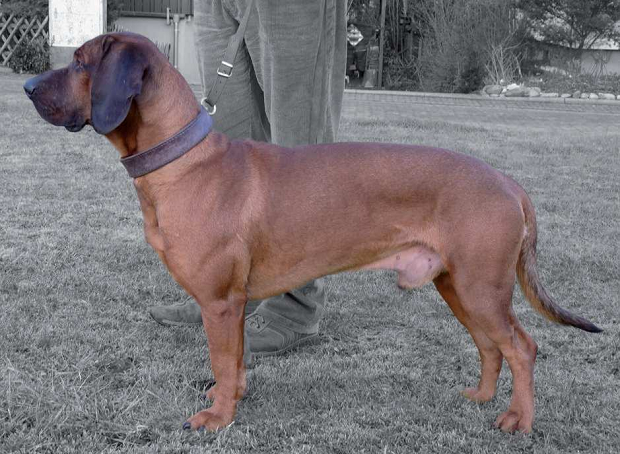 Male deer-red Male deer-red
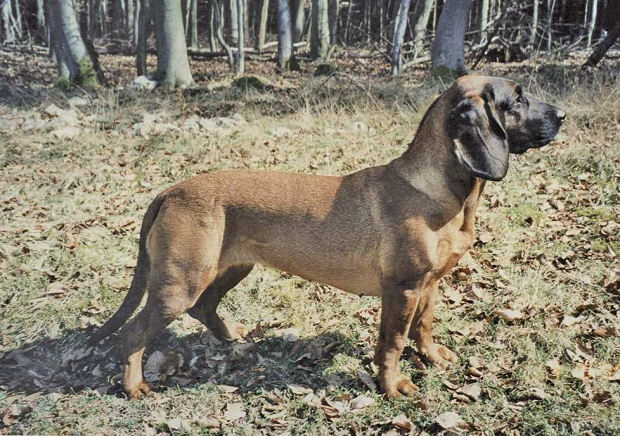
Female deer-red 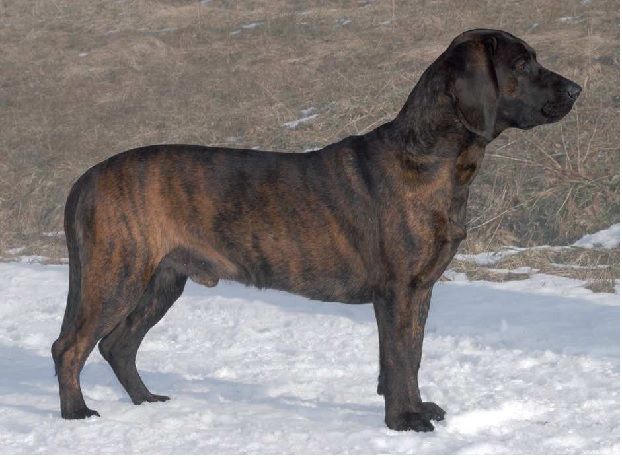 male brindle 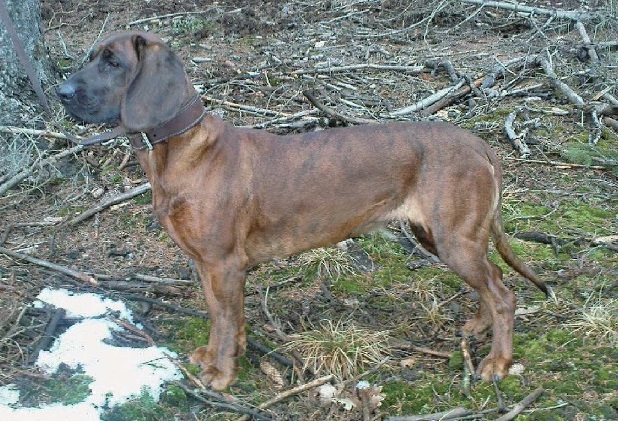 female brindle TRANSLATION: C. Seidler, revised by E.Peper, latest corrections &
revisions by Christina Bailey / Official version: (DE)
ORIGIN: Germany.
DATE OF PUBLICATION OF THE OFFICIAL VALID
STANDARD: 19.03.2015.
UTILIZATION: Tracking hound for wounded game, Scenthound.
In accordance with his hunting requirements as a highly
specialised huntingdog for the tracking of wounded game, the
Hannoverscher Schweißhund has to display all by the FCI
recognized Breed Club’s required hunting abilities, endurance,
potential the working trials and be useful for the more difficult
tracking of game.
FCI-CLASSIFICATION.: Group 6 Scenthounds and related breeds.
Section 2 Scenthounds/Leash Hounds.With working trial.
BRIEF HISTORICAL SUMMARY: The Hannoverscher
Schweißhund has developed almost unchanged from the so called
«liam hound» (leash hound) of the early Middle Ages. The Liam
hound, from the breed section of the «Bracke», already played an
extraordinary part at the time of the establishment of clan rights of the
Germanic tribes (in about 500AD). With the invention of firearms, the
methods of hunting big game altered. Dogs were needed to search for
wounded game. The liam hound offered the best conditions for this
and so he became a « Liam-Scenthound ».
This breed description stayed in place until the hunting estate of
the Kingdom of Hannover got more involved with this breed The
Hanoverian hunting estate in the kingdom of Hannover developed
this breed further and preserved the proven methods of handling
these hounds.
The Deutsche Schweißhund developed into the Hannoversche
Schweißhund. Since 1894 the registered «Verein Hirschmann e.V.»
has been taking care of the breed, Since then the breeding of these
dogs has continued strictly with regard of their working ability and
the dogs are used exclusively in hunting grounds for big game as
specialists in tracking cloven-hoof game. The dissertation of Dr.
Wolf-Eberhardt Barth of the “Forstlichen Fakultät of the Georg-
August University in G艖ttingen” about the subject “Der
Hannoversche Schweißhund as an example of the development of
the German Gundogs” (Magazines of the Landesjagdverbands
Freie und Hansestadt Hamburg e.V., Landesjägerschaft, Magazine
2, Hamburg 1970, 96 S) is the scientific base for the insight into the
history of this old gundog breed, which is correctly named German
culture asset (Deutscher Schweißhund).
GENERAL APPEARANCE: In general appearance the highly
efficient Hannoverscher Schweißhund is of medium size, well
proportioned and powerful. Well set strongly muscled fore and hind
limbs qualify him for tireless work. Too long legs, specially overbuilt
forequarters, affect his work with nose to ground and are foreign to his
type. The broad, deep chest provides ample room for the lungs and
enables long, strenuous chases.
The slightly wrinkled forehead and the clear dark eyes produce the
serious expression typical of the Hannoverscher Schweißhund. Also
typical for the breed is the red primary colour of the coat, which can
vary from a pale fawn colour to a dark brindle, almost black appearing
colouring.
IMPORTANT PROPORTIONS:
Length of body to height at withers: 1.4 to 1
Depth of chest to height at withers: 0.5 to 1
Length of bridge of nose to length of head: 0.5 to 1
BEHAVIOUR / TEMPERAMENT: Calm and assured temperament,
at the same time sensitive with his handler, choosy and discerning with
strangers.
High capabilities of concentration in any tracking work with strong
loyalty to the hunter in charge.
HEAD: Forehead slightly wrinkled.
CRANIAL REGION:
Skull: Broad, increasing in width towards the rear, flatly rounded.
Occiput barely pronounced. Seen from the side, superciliary ridges
clearly defined.
Stop: Mostly strongly pronounced, more so in males.
FACIAL REGION:
Nose: Broad, mostly black, rarely dark brown. Nose large, broad,
nostrils well opened. Bridge of nose slightly arched or almost straight;
more arched in males. Gradually narrowing towards forehead.
Muzzle: Strong, deep and broad. Well developed for being used (about
50% of length of head). Mandible strong.
Lips: Broad and pendulous, well rounded.
Jaws/Teeth: Jaws normally developed, very strong, straight, providing
all teeth with sufficient room. 42 teeth. Scissor or pincer bite.
Cheeks: Strongly muscled and very strong.
Eyes: Neither prominent nor deep-set, well fitting lids, darkbrown iris.
Free of ectropion or entropion.
Ears: Of medium length. Set on high and broad, smooth, hanging close
to the head without twist. Bluntly rounded at the tips.
NECK: Long and strong, gradually widening towards chest. Skin on
throat full and loose, slight dewlap permissible.
BODY:
Topline: Long, often slightly overbuilt.
Withers: With normal rise. Base of neck strong.
Back: Strong.
Loins: Broad and pliable with slight arch.
Croup: Broad and long, sloping slightly towards the tail.
Chest: Deep and spacious, deep rather than broad.
Underline and belly: In a gradually rising line slightly tucked up.
TAIL: High set-on, long and barely curved. Strong at set-on, gradually
tapering towards the tip.
LIMBS
FOREQUARTERS:
General appearance: Seen from the side, vertically set under the body
and straight. Seen from the front, straight, often standing close. Well in
proportion to the body.
Shoulder: Shoulder blade flat and close to the body, strongly muscled,
well laid back.
Upper arm: Long.
Elbow: Well set backwards, close to the body.
Forearm: Straight, well muscled.
Carpus (Wrist): Broad, almost straight.
Metacarpus (Pastern): Never totally steep.
Forefeet: Strong, round; toes well arched, well knit; pads large and
tough; strong nails.
HINDQUARTERS:
General appearance: Seen from the side, set under the body or slightly
standing back. Well angulated. Seen from behind, straight. For a
medium-sized dog which is longer than high, normal in proportion to
the body. Pelvis broad and capacious.
Thigh: Strongly muscled.
Stifle (Knee): With an angle of more than 120°.
Lower thigh: Straight and lean.
Hock joint: Broad and strong.
Metatarsus (Rear pastern): Almost vertical to the ground.
Hind feet: Rounded, well-knit toes.
GAIT/MOVEMENT: Able to move in all gaits, full of drive, flexible,
ground covering when galloping. Preferred gaits at work are the walk
or the gallop.
SKIN: Thick, rather loose, mostly wrinkled on the head, and
occasionally at the throat, too.
COAT
Hair: Short, thick, coarse to harsh; somewhat longer and coarser on the
rear edges of the upper thighs only. Coat on tail is dense and coarse, a
little longer and coarser on the underside.
Colour: Light to dark deer-red, more or less intensely brindled, with or
without mask. Small white patches on forechest to be tolerated.
SIZE AND WEIGHT:
Height at the withers: Males: 50–55 cm.
Females: 48–53 cm.
Weight: Males: 30–40 kg.
Females: 25–35 kg.
FAULTS: Any departure from the foregoing points should be
considered a fault and the seriousness, with which the fault should be
regarded should be in exact proportion to its degree and its effect upon
the health and welfare of the dog and its ability to perform its
traditional work.
• Square build.
• Fine bones.
• Lack of the first premolar (PM1) or of other teeth.
• Under- or overshot bite.
• Ectropion, entropion.
• Twisted or small ears.
• Hindquarters strongly overbuilt.
• Swayback or roach back.
• Barrel shaped ribcage.
• Strongly curved or thin tail.
• Steep or loose shoulders.
• Strongly cow-hocked or bandy-legged.
• Splayed feet, harefeet.
DISQUALIFYING FAULTS:
• Aggressive or overly shy dogs.
• Any dog clearly showing physical of behavioural abnormalities
shall be disqualified.
• The above mentioned faults when occurring to a highly marked
degree or frequently are disqualifying.
N.B.:
• Male animals should have two apparently normal testicles fully
descended into the scrotum.
• Only functionally and clinically healthy dogs, with breed
typical conformation, should be used for breeding.
The latest amendments are in bold characters.
Source:FCI-Standard (www.fci.be)
ALPINE DACHSBRACKE
(Alpenländische Dachsbracke) 18.06.1996/EN FCI-Standard N° 254
TRANSLATION : C. Seidler.
ORIGIN : Austria.
DATE OF PUBLICATION OF THE OFFICIAL VALID
STANDARD : 10.10.1995.
UTILIZATION : A robust, weather resistant working dog used by
the mountain huntsman. The Alpine Dachsbracke is used as a
tracking hound for wounded deer and as scenthound for hare and fox.
FCI-CLASSIFICATION : Group 6 Scenthounds and related
breeds.
Section 2 Leash (scent) hounds.
With working trial.
BRIEF HISTORICAL SUMMARY : Already in ancient times, a
hunting/shooting dog was used which bore a remarkable resemblance
in appearance to the Alpine Dachsbracke. Crown Prince Rudolf of
Habsburg in 1881 and 1885 made his gamekeepers from Mursteg
and Ischl include Alpine Dachsbracken on his hunting trips to
Turkey and to Egypt. In 1932 the “Alpine- Erzgebirgs-
Dachsbracke” was recognized by the top canine organisations in
Austria as the third Scenthound breed. In 1975 the name was altered
to “Alpenländische Dachsbracke” and the F.C.I. declared Austria as
the country of origin. In 1991 the Alpenländische Dachsbracke was
included in Section 2 of Scenthounds in the FCI nomenclature.
GENERAL APPEARANCE : A short legged, sturdy hunting dog
with a robust, strong boned body structure, dense coat, firm muscles.
IMPORTANT PROPORTIONS :
• Relation of height at shoulder to length of body = 2 : 3.
• Relation of facial region to cranial region = 9 : 10.
FCI-St. N° 254 / 18.06.1996
3
BEHAVIOUR / TEMPERAMENT : Expression intelligent and
friendly. Fearless personality.
HEAD
CRANIAL REGION :
Skull : Lightly arched. Well defined furrow in fore-head, lightly
emphasized occiput.
Stop : Pronounced.
FACIAL REGION :
Nose : Black.
Muzzle : Strong.
Lips : Close fitting with black pigment, moderately rounded curve of
lips.
Jaws/Teeth : Strong complete teeth with scissor or pincer bite. A
complete set with 42 teeth is sought after; the absence of totally two
PM1 or PM2 (premolar 1 or 2) is tolerated; the M3 (molar 3) are not
taken into account.
Eye : With dark brown iris. Eyelids close fitting to eyeballs with
black pigment.
Leathers : Set on high without folds, hanging broad and smooth,
medium length (should reach to the canines), well rounded at tips.
NECK : Muscular, not too long.
BODY : Trunk strong and well muscled, elongated.
Withers : Moderately emphasized.
Back : Straight.
Loins : Short and broad.
Croup : Barely sloping.
Chest : Deep and broad with pronounced forechest. Depth of chest
should be about half the height at shoulder.
Belly : Moderately tucked up.
TAIL : Set on high, thick at root. Longer hair on underside (brush
tail); reaching barely to ground, carried slightly downward.
FCI-St. N° 254 / 18.06.1996
4
LIMBS
FOREQUARTERS :
General appearance : Front legs are straight and strong; they appear
short in relation to the body.
Shoulders : Shoulder blade close fitting, long, sloping and strongly
muscled.
HINDQUARTERS :
General appearance : Muscular, strong and well angulated. Seen
from the rear, the axis of the legs is straight.
FEET : Front and hind feet strong, round, toes tight against each
other. Strong pads and black nails.
GAIT / MOVEMENT : Movement is ground covering, not
tripping. Preferred gait : Trot.
SKIN : Elastic and strong, without wrinkles.
COAT
HAIR : The double coat consists of very thick top coat and a dense
undercoat, which covers the whole body and is close fitting.
COLOUR : The ideal colour is dark deer red with or without black
hairs lightly interspersed. Also black with clearly defined red-brown
markings on head (Vieräugl), chest, legs, feet and underside of tail.
White star on chest permitted.
SIZE :
Height at withers : 34-42 cm.
Ideal height for dogs : 37-38 cm.
Ideal height for bitches : 36-37 cm.
FCI-St. N° 254 / 18.06.1996
5
FAULTS : Any departure from the foregoing points should be
considered a fault and the seriousness with which the fault should be
regarded should be in exact proportion to its degree and its effect
upon the health and welfare of the dog.
• Weak bone.
• Lack of muscle.
• Too pointed, too short or too long in muzzle.
• Too light eye, lids not close fitting.
• Short or pointed leathers.
• Loose shoulders.
• Wrong stance of front or hind legs.
• Coat too thin or too short.
• Slight departure from correct colour.
DISQUALIFYING FAULTS :
• Aggressive or overly shy.
• Any dog clearly showing physical or behavioural
abnormalities shall be disqualified.
• Any deviation which will hinder ability to hunt.
• Lack of more than two premolars 1 or 2 (the M3 are not
taken into account).
• Height at withers less than 34 cm and more than 42 cm.
• Weakness in temperament.
N.B.:
• Male animals should have two apparently normal testicles
fully descended into the scrotum.
• Only functionally and clinically healthy dogs, with breed
typical conformation should be used for breeding.
Last modified: : 2019-01-16 14:23:59 by wjez
| 


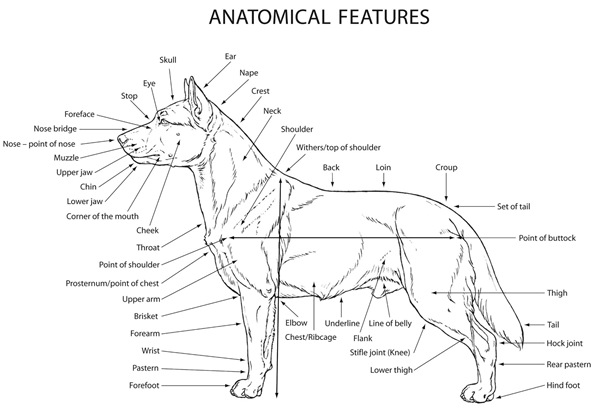
 Male deer-red
Male deer-red

